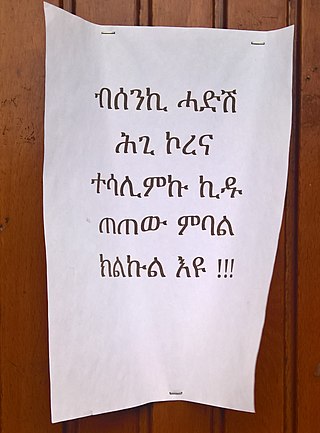Velars are a type of consonant.
Velar may also refer to:
Approximants are speech sounds that involve the articulators approaching each other but not narrowly enough nor with enough articulatory precision to create turbulent airflow. Therefore, approximants fall between fricatives, which do produce a turbulent airstream, and vowels, which produce no turbulence. This class is composed of sounds like and semivowels like and, as well as lateral approximants like.
Diaeresis may refer to:
Theme or themes may refer to:
Velars are consonants articulated with the back part of the tongue against the soft palate, the back part of the roof of the mouth.

Tigrinya is an Ethiopian Semitic language commonly spoken in Eritrea and in northern Ethiopia's Tigray Region by the Tigrinya and Tigrayan peoples. It is also spoken by the global diaspora of these regions.
Labialization is a secondary articulatory feature of sounds in some languages. Labialized sounds involve the lips while the remainder of the oral cavity produces another sound. The term is normally restricted to consonants. When vowels involve the lips, they are called rounded.
The voiced labial–velar approximant is a type of consonantal sound, used in certain spoken languages, including English. It is the sound denoted by the letter ⟨w⟩ in the English alphabet; likewise, the symbol in the International Phonetic Alphabet that represents this sound is ⟨w⟩, or rarely, and the equivalent X-SAMPA symbol is w. In most languages it is the semivocalic counterpart of the close back rounded vowel. In inventory charts of languages with other labialized velar consonants, will be placed in the same column as those consonants. When consonant charts have only labial and velar columns, may be placed in the velar column, (bi)labial column, or both. The placement may have more to do with phonological criteria than phonetic ones.

Telugu script, an abugida from the Brahmic family of scripts, is used to write the Telugu language, a Dravidian language spoken in the Indian states of Andhra Pradesh and Telangana as well as several other neighbouring states. It is one of the official scripts of the Indian Republic. The Telugu script is also widely used for writing Sanskrit texts and to some extent the Gondi language. It gained prominence during the Eastern Chalukyas also known as Vengi Chalukya era. It shares extensive similarities with the Kannada script, as both of them evolved from the Bhattiprolu and Kadamba scripts of the Brahmi family. In 2008, the Telugu language was given the status of a Classical Language of India, in recognition of its rich history and heritage.
Labial–velar consonants are doubly articulated at the velum and the lips, such as. They are sometimes called "labiovelar consonants", a term that can also refer to labialized velars, such as the stop consonant and the approximant.
Short may refer to:
Rhotic is a term in linguistics which may refer to:
Umlaut may refer to:
Gh is a digraph found in many languages.
The pronunciation of the digraph ⟨wh⟩ in English has changed over time, and still varies today between different regions and accents. It is now most commonly pronounced, the same as a plain initial ⟨w⟩, although some dialects, particularly those of Scotland, Ireland, and the Southern United States, retain the traditional pronunciation, generally realized as, a voiceless "w" sound. The process by which the historical has become in most modern varieties of English is called the wine–whine merger. It is also referred to as glide cluster reduction.
The phonology of the Proto-Indo-European language (PIE) has been reconstructed by linguists, based on the similarities and differences among current and extinct Indo-European languages. Because PIE was not written, linguists must rely on the evidence of its earliest attested descendants, such as Hittite, Sanskrit, Ancient Greek, and Latin, to reconstruct its phonology.
In phonetics and phonology, relative articulation is description of the manner and place of articulation of a speech sound relative to some reference point. Typically, the comparison is made with a default, unmarked articulation of the same phoneme in a neutral sound environment. For example, the English velar consonant is fronted before the vowel compared to articulation of before other vowels. This fronting is called palatalization.
Labiovelar consonant may refer to:
Palatalization is a historical-linguistic sound change that results in a palatalized articulation of a consonant or, in certain cases, a front vowel. Palatalization involves change in the place or manner of articulation of consonants, or the fronting or raising of vowels. In some cases, palatalization involves assimilation or lenition.
Gumuz is a dialect cluster spoken along the border of Ethiopia and Sudan. It has been tentatively classified within the Nilo-Saharan family. Most Ethiopian speakers live in Kamashi Zone and Metekel Zone of the Benishangul-Gumuz Region, although a group of 1,000 reportedly live outside the town of Welkite. The Sudanese speakers live in the area east of Er Roseires, around Famaka and Fazoglo on the Blue Nile, extending north along the border. Dimmendaal et al. (2019) suspect that the poorly attested varieties spoken along the river constitute a distinct language, Kadallu.